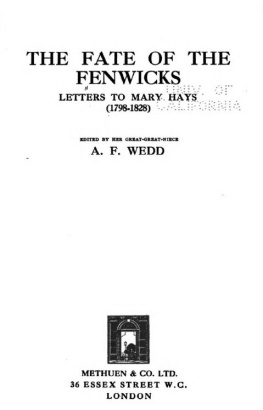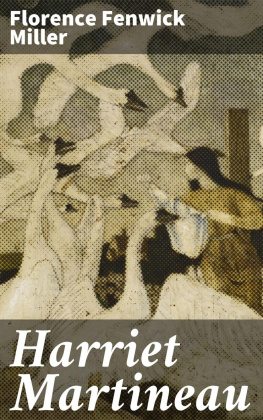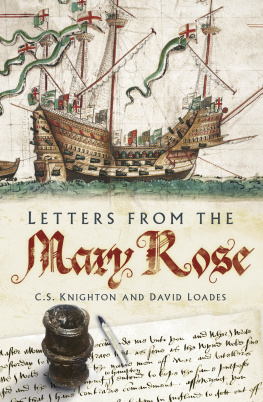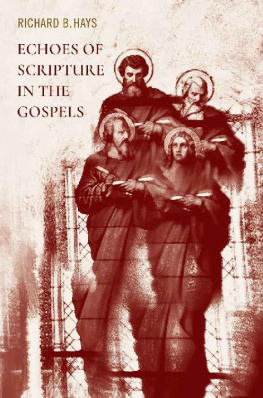Eliza Fenwick (1766-1840) - The Fate of the Fenwicks: Letters to Mary Hays (1798-1828)
Here you can read online Eliza Fenwick (1766-1840) - The Fate of the Fenwicks: Letters to Mary Hays (1798-1828) full text of the book (entire story) in english for free. Download pdf and epub, get meaning, cover and reviews about this ebook. publisher: Methuen & Co., genre: Detective and thriller. Description of the work, (preface) as well as reviews are available. Best literature library LitArk.com created for fans of good reading and offers a wide selection of genres:
Romance novel
Science fiction
Adventure
Detective
Science
History
Home and family
Prose
Art
Politics
Computer
Non-fiction
Religion
Business
Children
Humor
Choose a favorite category and find really read worthwhile books. Enjoy immersion in the world of imagination, feel the emotions of the characters or learn something new for yourself, make an fascinating discovery.
- Book:The Fate of the Fenwicks: Letters to Mary Hays (1798-1828)
- Author:
- Publisher:Methuen & Co.
- Genre:
- Rating:3 / 5
- Favourites:Add to favourites
- Your mark:
- 60
- 1
- 2
- 3
- 4
- 5
The Fate of the Fenwicks: Letters to Mary Hays (1798-1828): summary, description and annotation
We offer to read an annotation, description, summary or preface (depends on what the author of the book "The Fate of the Fenwicks: Letters to Mary Hays (1798-1828)" wrote himself). If you haven't found the necessary information about the book — write in the comments, we will try to find it.
The Fate of the Fenwicks: Letters to Mary Hays (1798-1828) — read online for free the complete book (whole text) full work
Below is the text of the book, divided by pages. System saving the place of the last page read, allows you to conveniently read the book "The Fate of the Fenwicks: Letters to Mary Hays (1798-1828)" online for free, without having to search again every time where you left off. Put a bookmark, and you can go to the page where you finished reading at any time.
Font size:
Interval:
Bookmark:
THE FATE OF THE FENWICKS
LETTERS TO MARY HAYS
(1798-1828)
EDITED BY HER GREAT-GREAT-NIECE
A. F. WEDD
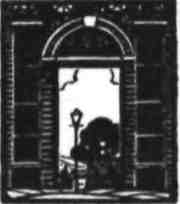
METHUEN & CO. LTD.
36 ESSEX STREET W.C.
LONDON
BY THE SAME EDITOR
THE LOVE LETTERS OF MARY HAYS
(1779-1780)
First Published in 1927
PRINTED IN GREAT BRITAIN
IN ENGLAND
1. The First School
2. Another Request
3. The School is Begun
4. Orlando Walks Alone
5. A Wetting
6. Misgivings
7. Floods and a Phenomenon
8. Flight from London
9. Another Temporary Refuge
10. An Experiment in Shop-Keeping
11. Winter in Penzance
12. The Opening op Elizas Career
13. Eliza makes Progress
14. More of Eliza
15. Reconciliation with the Lambs
16. Slavery in Skinner Street
17. Mary Hays to the Rescue
18. A Favourable Turn of Fortunes Wheel
19. Preparations
20. An Adventurous Journey
21. Lanno at Wandsworth
22. Life at the Mocattas
23. Eliza at Covent Garden
24. First Talk of Barbadoes
25. The Barbadoes Offer Accepted
26. More of Lanno
27. Mrs M. is Surprisingly Considerate
28. Brother and Sister
29. Mr F. Shows Signs of Grace
30. Written from the Lambs
31. Eliza Gone
32. Needless Alarm
33. Mr. Whitaker
34. Plans for Lanno
35. Christmas Holidays
36. Mrs F. is Misunderstood
ELIZAS VENTURE
37. Eliza to her Mother
38. The First News of Eliza
39. Elizas Success
40. Orlando and the East India Company
41. To Orlando
42. Lannos Persuasiveness
43. Concerning Lanno Again
44. Fresh Proposals from Ireland
45. Elizas Triumphs
46. First Mention of Mr Rutherford
47. Eliza Plans for Orlando
48. Mr. Honnor Introduced
IRELAND
49. An Earthly Paradise
50. Eliza Describes Strange Phenomena
51. Eliza and Mr Rutherford
52. Mrs. Fenwicks Occupations
53. Anxiety about Eliza
54. News of Elizas Sudden Marriage
55. Eliza Relates her Adventures
56. From Mr. Rutherford to Mrs. Fenwick
57. Mrs. Fenwick is Again Anxious
58. Tidings At Last
59. Mrs. F. Talks of Going to Barbadoes
60. Eliza gives her Mother a great Surprise
61. The Schoolroom at Lee Mount
62. Fresh Plans for Orlando
63. The Barbadoes Scheme Abandoned
THE WEST INDIES
64. Reunion
65. School-keeping in Barbadoes
66. Prosperity
67. After the Slave Rebellion ..
68. A Terrible Storm
69. Orlandos Death
70. A Sorrowful Letter
71. Elizas Illness
72. The Truth about Mr. Rutherford
73. Mrs. Fenwick announces her Return to England
74. The Dream Ended
75. Minor Trials
76. Further Misfortunes and a Ball
77. Another Plan Mooted
78. Last Months in Bridgetown
AMERICA
79. First Impressions
80. Losses and Gains
81. Infirmities and Disappointments
82. Atrocious Calumnies
83. Another Move
84. A Melancholy Report
85. Further Anxieties
86. The Last Enterprise
INTRODUCTION
ALL who are familiar with the Letters and Essays of Charles Lamb will remember the names of Mr. and Mrs. Fenwick. References to them both are frequent, and they appear in many other literary biographies and memoirs of the early nineteenth century as friends also of William Godwin, Mary Wollstonecraft, Thomas Holcroft and Crabb Robinson. Their later history has however up to the present time been unknown, and one of the greatest authorities on that period merely states that they went abroad, and regrets that nothing further can be ascertained about this interesting couple.
The correspondence of Mary Hays supplies the desired information in a large packet of letters from which the present volume has been compiled. Torn, mouse-eaten, and discoloured, they are closely written on large sheets of paper, some of which measure twenty inches by ten with as many as forty-six lines to the page. Some, consisting mainly of tiresome repetitions, have been altogether omitted. The remainder have been subjected to no alteration beyond the elimination of extraneous matter, division into paragraphs, and some additions in punctuation.
Mary Hays and Mrs. Fenwick were probably introduced to one another by Mary Wollstonecraft; together they ministered to her when she was dying, and they remained close friends, through a period of over thirty years.
The letters, which date from 1798 to 1828, give not only details of the chequered careers of John Fenwick and his wife, but also the whole life-history of their two children, Eliza and Orlando, a delightful pair who were the pets and protgs and often inmates of the home of Charles and Mary Lamb.
Fenwick himself seems to have been a thorough scamp, with all the charm and attractiveness of the typical neer-do-weel. His talent for borrowing was phenomenal and is immortalized by Elia in the Two Races of Men, where Fenwick is described as my old friend Ralph Bigod Esq.. When this Essay was written his creditors were apparently still complacent, but a time soon came when his utter irresponsibility with regard to money landed him in serious difficulties. As a boon companion of Charles Lamb, the first steps in his downward course must have been innocent and pleasant enough, but his naturally vicious tendencies eventually plunged him into habitual drunkenness, debt and disaster. In 1799 he fled to Dublin, and on September 28th, 1802, Lamb writes to Coleridge: Fenwick is a ruined man. He is hiding himself from his creditors and has sent his wife and children into the country. In 1806, Lamb tells Hazlitt that: Fenwick is coming to town, if no kind angel intervenes, to surrender himself to prison; and two years later, in a letter to Manning, Lamb says: Little Fenwick is in the Rules of the Fleet. Cruel conditions. Operation of iniquitous laws. Is Magna Charta then a mockery?
Mrs. Fenwick, whom these letters prove to have been warmhearted and generous, but recklessly impulsive and as unpractical as her miserable husband, tried by ever-varying means to earn or beg money for the support of herself and her family. Had she but stuck to one occupation, or known how to make the best use of such funds as came into her hands, she might have fared better. She is always moving from one lodging to another and from place to place. She tries in turn writing, school-keeping, helping in her brother-in-laws shop, translating, and colouring prints, previous to acting as resident governess in the Mocatta and Honnor families. For her to declare that any scheme has been abandoned invariably ensures the subsequent announcement of its having been put into execution. A chance piece of advice, the casual suggestion of an acquaintance, is enough to change the mind of this weather-cock woman. No sooner is she settled in one employment than she is off to another. Directly a school begins to pay she gives it up. She is sometimes penniless and sometimes comparatively affluent, but never does she succeed in making her income cover her expenses. Yet some mysterious force of character she must have possessed, for she exercised an unbounded influence over her two children, and ruled her pupils, even one whom she describes as having a devil of a temper, with calm determination.
Eliza, though meekly subservient to her mother and resembling her in many ways, had evidently a much greater amount of self-control and common-sense, added to a fund of humour which she must have inherited from her father. With her nervous dread of any public appearance it is astonishing that she should ever have consented to become an actress, but having adopted that career in deference to her mothers wishes, she had enough talent and perseverance to make it a success, and to become eventually the little idol of a West Indian audience. When only about seventeen she was acting in the private theatres in London, and in 1810 she secured an engagement at Covent Garden with the famous John Philip Kemble. Her name may be seen on many of the old play-bills now preserved in the South Kensington Museum, but Black Jacks treatment of her was not in accordance with his promises; she left Covent Garden in 1811, and not long afterwards sailed with Mr. Dykes Company for Barbadoes.
Next pageFont size:
Interval:
Bookmark:
Similar books «The Fate of the Fenwicks: Letters to Mary Hays (1798-1828)»
Look at similar books to The Fate of the Fenwicks: Letters to Mary Hays (1798-1828). We have selected literature similar in name and meaning in the hope of providing readers with more options to find new, interesting, not yet read works.
Discussion, reviews of the book The Fate of the Fenwicks: Letters to Mary Hays (1798-1828) and just readers' own opinions. Leave your comments, write what you think about the work, its meaning or the main characters. Specify what exactly you liked and what you didn't like, and why you think so.

